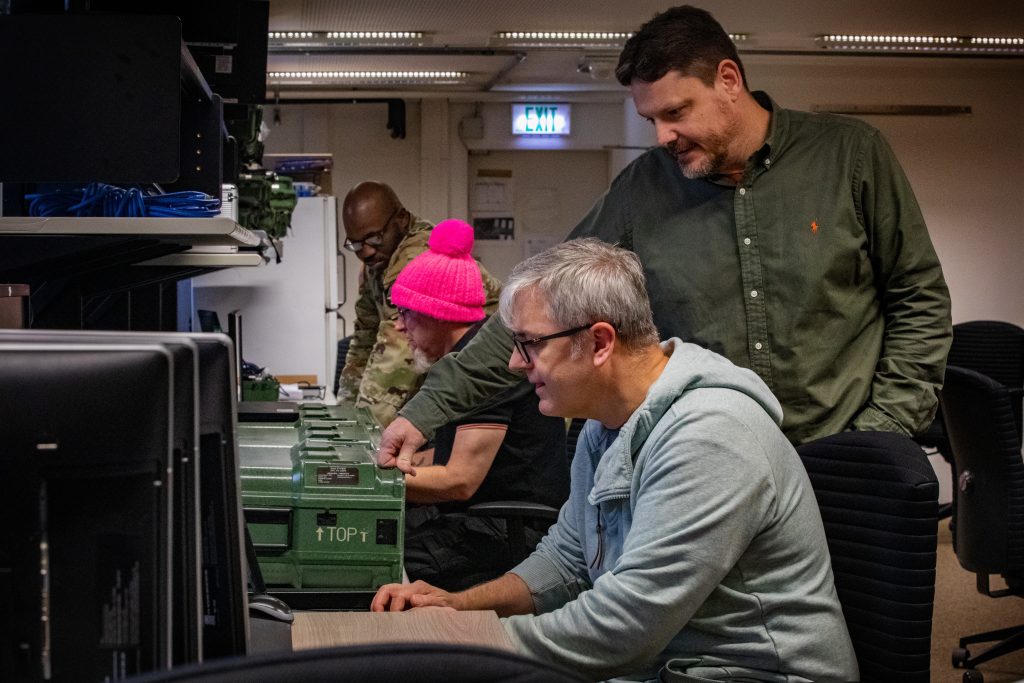
BUILDING A DIGITAL WAREHOUSE: FOSS can be compared to a massive warehouse with digital building blocks that can be assembled into custom solutions to meet operational needs. (Photo by Staff Sgt. Richard Lutz, 982nd Signal Company)
Leveraging Free and Open-Source Software on the battlefield.
by Capt. Noe Lorona
DOD has witnessed the pivotal role technology plays on the modern battlefield and felt the sting of relying on software that fails to meet dynamic needs—clunky interfaces, outdated features, a degraded user experience—,and is frustratingly unable to adapt at the speed of war. It is an issue that hampers operational effectiveness and can also jeopardize mission success. There is a need to maintain momentum in transforming military personnel from mere consumers of technology into active creators through initiatives within each military service. That is where the vast potential of Free and Open-Source Software (FOSS) comes into play.
FOSS refers to software that is freely licensed to use, modify and distribute. The “free” aspect means users have the freedom to run the software for any purpose, to study and modify the software, and to redistribute copies of either the original or modified software without having to pay royalties to previous developers. The “open-source” aspect emphasizes the availability of the software’s source code to the public, encouraging collaborative and transparent development that allows for continuous improvement and adaptation of the software. DOD champions the use of FOSS as a strategic component of its operations. DOD’s Office of the Chief Information Officer leads this initiative, emphasizing the integration of FOSS to enhance software modernization activities. This approach aligns with DOD’s commitment to developing secure, resilient software quickly and efficiently, in accordance with its 2018 Cyber Strategy and the DOD Software Modernization Strategy, ensuring that FOSS remains integral to meeting the nation’s defense needs effectively.
Unlike proprietary software that is locked behind paywalls and licensing requirements, FOSS provides a flexible toolkit DOD can leverage to address the challenges it is facing. This flexibility is evident in the use of tools like Git for collaborative code management and Jenkins for continuous integration and deployment, streamlining the software development process. For artificial intelligence and machine learning tasks, DOD can use FOSS tools like TensorFlow for building and training neural networks or Apache Hadoop for processing large datasets, enhancing its capability to adapt and innovate in response to evolving military needs.

FOSS FLEXIBILITY: Relying on outdated software that fails to meet Soldier needs can jeopardize mission success. FOSS provides more flexibility than proprietary software, which often locks essential features behind a paywall. (Photo by Luis Gomes, Pexels)
Imagine FOSS as a massive warehouse with digital building blocks such as code, libraries and complete frameworks. These building blocks can be assembled into custom solutions tailored to unique operational needs. A scenario could include a unit operating in a region with limited connectivity where commercial communication systems might falter, causing isolation. In such cases, FOSS enables tech-savvy Soldiers to use open-source technologies to build and deploy a code solution, re-establishing communications systems and moving away from antiquated pen and paper solutions, which are often not scalable. In an isolated operational environment, using Jenkins would enable the unit to continuously integrate and deploy software once it has been updated for security vulnerabilities or enhanced with new features. The source code for these updates could be managed and version-controlled in a Git repository, hosted on a local server within the unit’s network. This setup ensures that even in disconnected or bandwidth-limited situations, the unit can maintain up-to-date software, enhancing operational effectiveness and cybersecurity resilience. Then the solution can be better codified by a software factory or used as a prototype for a contractable solution.
The power of FOSS extends far beyond rapid prototyping, unlocking Soldier-driven innovation. A Soldier working in logistics may have an idea for streamlining supply chain management. Instead of filing a suggestion report for the currently used software and hoping for the best, they can use FOSS frameworks such as Angular and Django to create a proof of concept. Angular’s robust front-end development capabilities can facilitate the creation of an intuitive user interface for tracking and managing supplies in real time. Concurrently, Django, with its efficient back-end structure, can be used for complex data processing and integration with existing military databases. The application may perform some lightweight tasks, which could be containerized with Docker or Kaniko. These tools allow the application to be standardized and isolated from its environment, making it portable and consistent across any computing platform. The application can then be deployed and shared with other units, giving them the ability to deploy the application in a Kubernetes cluster or other container orchestration services. Kubernetes, a popular orchestration system, manages the deployment, scaling and operations of these containers across a cluster of virtual machines. Putting this power in the hands of Soldiers in the battlefield leverages the power of innovation and FOSS. This approach fosters an environment where the best ideas are given space and tooling to be developed and deployed by Soldiers who will use them on the front lines.

U.S. Army Capt. Craig Neal, a chemical, biological, radiological and nuclear officer at 30th Medical Brigade (top), helps Capt. Julio Rodriguez, a health services plans, operations, intelligence, security and training officer at 30th Medical Brigade (bottom) on his computer while trying to find documentation for a mission during a Command Post Exercise on Rhine Ordnance Barracks, Kaiserslautern, Germany on March 16, 2023. The Command Post Exercise was held to prepare junior Soldiers and senior leaders for Defender ‘23 using real world scenarios. (U.S. Army photo by Spc. Samuel Signor)
TRAINING THE NEXT GENERATION OF SOLDIER-DEVELOPERS
Initiatives like the Army Software Factory, Kessel Run (U.S. Air Force), Kobayashi Maru (U.S. Space Force) and the U.S. Marine Corps Software Factory are at the forefront of this transformation, and have leveraged FOSS to train, enable and deliver software to DOD. These factories are not only upskilling service members, but also providing commanders with organic problem-solvers who can be deployed as strategic assets. DOD is learning the importance of the potential of FOSS, modern development practices that emphasize agility and the principles of DevSecOps, where security is woven into the fabric of software from day one. These programs align with DOD’s emphasis on building a technologically empowered force.

HIGH-TECH SOLDIERS: Making FOSS readily available creates a more technologically advanced Soldier and fosters an environment that encourages design and development of software solutions that meet the needs of front-line warfighters. (Photo by Pfc. Luciano Alcala, 50th Public Affairs Detachment)
NAVIGATING CHALLENGES AND EMBRACING COLLABORATION
Some might question the practicality of FOSS. Will it create a patchwork of unmanageable custom tools? This is a valid concern. That’s why there also needs to be a push to promote collaboration and secure knowledge sharing. Imagine repositories where proven solutions are not locked away, but accessible to units across the force. A breakthrough developed to streamline medical logistics in one theater could be adapted and deployed to others, multiplying its impact and reducing duplicative efforts. This collaborative model reinforces DOD’s guidance on open-source software (OSS), which highlights the importance of knowledge-sharing to maximize the potential of open-source solutions. As a caveat, there exists the need for a legal review of approved OSS; special licensing and user agreements need to be reviewed by the proper legal team to ensure licensing compliance.

COLLABORATE, CREATE, INNOVATE: Army Software Factory engineers work on projects at Grafenwoehr Training Area, Germany, in February 2023, part of the Army Software Factory’s initiative to collaborate with civilian engineers and Army developers to create innovative, technology-based solutions to the military’s biggest challenges. (Photo by Staff Sgt. Ashley Low, 7th Army Training Command)
CONCLUSION
Integrating FOSS in military operations is not just about technological advancement. It signifies a fundamental shift toward a more agile, innovative and technologically proficient military force. The Army’s new software policy and the growing recognition of FOSS’s value herald a future where military innovation is continuous, collaborative and deeply integrated into defense strategies. As our adversaries also navigate the digital terrain, leading the race to harness the full spectrum of technological innovation will be critical in defining the future of military supremacy.
For more information on open-source software, go to https://dodcio.defense.gov/Open-Source-Software-FAQ/#q-isnt-using-open-source-software-oss-forbidden-by-dod-information-assurance-ia-policy.
CAPT. NOE LORONA is an active duty Army captain assigned to the Signal Branch. He serves as a platform engineer for the Army Software Factory, where he plans, develops and deploys cloud architecture to support Agile application development. He holds a Doctor of Management from Colorado Technical University and an M.S. in management and a B.S. in information technology, both from National American University. His professional certifications include Certified Associate in Project Management from the Project Management Institute and six Computing Technology Industry Association certifications.


